Leading Innovations
Smart and simple components. Reduced to the essentials. Designed to last.
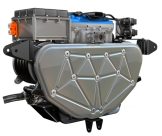
Zero Vibration Generator
The Zero Vibration Generator is a generator-integrated combustion engine boasting best-in-class efficiency and packaging.
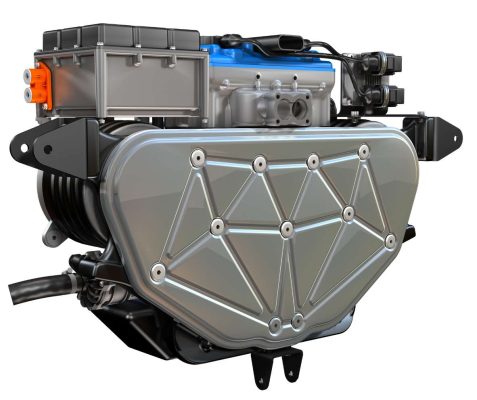
The Zero Vibration Generator
The Zero Vibration Generator has an ultra-compact design that is reduced to the essentials. This goes hand-in-hand with a lightweight construction and low assembly and maintenance costs. To overcome the vibration challenges of a two-cylinder engine, a novel twin crankshaft configuration was selected. Counter-rotating crankshafts allow for optimised mass balancing. With its engine characteristics, the Zero Vibration Generator is an ideal power source for electrifying vehicles and perfect for powering a series hybrid vehicle.
Zero Vibration Generator
advantages at a glance
-
Superior NVH
Behavior -
Application
-
Technical data
Special emphasis was placed on noise and vibration reduction during the design phase of the Zero Vibration Generator.
To overcome the vibration challenges of a two-cylinder engine, a novel twin crankshaft configuration was selected. Counter-rotating crankshafts allow for optimized mass balancing. Generator and engine noise is also reduced thanks to the combined acoustic and thermal insulation. This insulation allows the thermal management system to use the engine as a heat source when temperatures are at their lowest.
With its engine characteristics, the Zero Vibration Generator is an ideal power source for electrifying vehicles and perfect for powering a series hybrid vehicle.
Due to its compactness and design features, the engine’s mounting position can be arbitrarily selected, providing automotive engineers with unprecedented freedom in hybrid powertrain packaging.
- Generator Power 40kWe Baseline (85-100kWe high-power versions)
- Engine Displacement of 999ccm (multi-fuel calibration)
- Four Stroke Two-Cylinder Engine (naturally aspirated)
- SFC_DC: 258g/kWh
- Engine Weight: 95kg (without fluids)
- Compact Design (677 x 498 x 188 mm)
Special emphasis was placed on noise and vibration reduction during the design phase of the Zero Vibration Generator.
To overcome the vibration challenges of a two-cylinder engine, a novel twin crankshaft configuration was selected. Contra-rotating crankshafts allow for optimized mass balancing. Generator and engine noise is also reduced thanks to the combined acoustic and thermal insulation. This insulation allows the thermal management system to use the engine as a heat source when temperatures are at their lowest.
With its engine characteristics, the Zero Vibration Generator is an ideal power source for electrifying vehicles and perfect for powering a series hybrid vehicle.
Due to its compactness and design features, the engine’s mounting position can be arbitrarily selected, providing automotive engineers with unprecedented freedom in hybrid powertrain packaging.
- Generator Power 40kWe Baseline (85-100kWe high-power versions)
- Engine Displacement of 999ccm (multi-fuel calibration)
- Four Stroke Two-Cylinder Engine (naturally aspirated)
- SFC_DC: 258g/kWh
- Engine Weight: 95kg (without fluids)
- Compact Design (677 x 498 x 188 mm)
key facts
- Symmetrical Generator and Main Drive Position
- Counter-rotating Crankshafts (balancing of 1st order)
- Double Speed Contra-rotating Generators (balancing of 2nd order)
- Full Load Operation at λ=1: (lowest cost for emission after-treatment)
- Lowest NOx and PM Issues (due to simple intake manifold fuel injection)
- Capability (to fulfil more stringent future emission regulations)
check out the media to this topic
Zero Vibration Generator
Zero Vibration Coin Demonstration
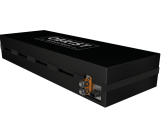
Vacuum fixation Li-IOn battery
Our batteries for PHEV and BEV applications are designed to fulfil customer expectations especially with increased specific energy and reduced costs.
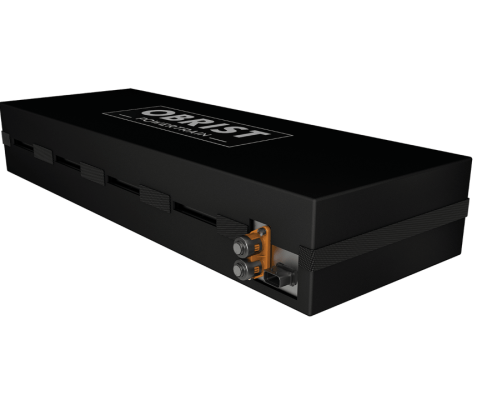
More energy - less weight
Our batteries for PHEV and BEV applications are designed to fulfil customer expectations, especially increased specific energy and reduced costs. The most significant factors are the low costs and flexible battery pack design using cylindrical or pouch cells. Our module aluminum housing works as a temperature heat sink, eliminating internal heat exchangers. In addition, the whole system was designed with a strong focus on excellent component integration to reduce complexity and material costs. The battery architecture has been tailored to automated production to achieve an extra level of reliability.
VACUUM FIXATION LI-ION BATTERY
advantages at a glance
-
More Energy
- Less Weight -
Cost
Reduction
-
Design
Features
The 17.3kWh PHEV module comes with a specific energy density level of 203Wh/kg and 110kW continuous discharge power. When adapting this module for BEV applications, the specific energy density reaches 224Wh/kg with cylindrical cells or 231Wh/kg with pouch cells.
The most significant factors are the low costs and flexible battery pack design using cylindrical or pouch cells. Our module aluminum housing works as a temperature heat sink, eliminating internal heat exchangers. In addition, the whole system was designed with a strong focus on excellent component integration to reduce complexity and material costs. The battery architecture has been tailored to automated production to achieve an extra level of reliability.
Evolutionary Vacuum Fixation Technology:
- Low weight with extreme specific energy density values
- Low cost and flexible battery pack design (cylindrical or pouch cells)
- Efficient air cooling system
- Fewer battery pack parts for improved cost and reliability
- Improved battery pack safety due to rigid construction
- Rugged design for challenging environments (IP69k certification)
- Thermal insulation for independence from ambient conditions (extends service life)
- Can be designed from low (48VDC) to high voltage (1200VDC)
- Universal battery that can be customized per customer demand (modular design)
- Module aluminum housing works as a temperature sink, eliminating internal heat exchangers
Evolutionary Vacuum Fixation Technology:
- low weight with extreme specific energy density values
- low cost and flexible battery pack design (cylindrical or pouch cells)
- efficient air cooling system
- fewer battery pack parts for improved cost and reliability
- improved battery pack safety due to rigid construction
- rugged design for challenging environments (IP69k certification)
- Thermal insulation for independence from ambient conditions (extends service life)
- Can be designed from low (48VDC) to high voltage (1200VDC)
- Universal battery that can be customized per customer demand (modular design)
- Module aluminum housing works as a temperature sink, eliminating internal heat exchangers
key facts
- Energy: 17.3kWh (100s16p)
- Nominal voltage: 360VDC (420V-240V)
- Continuous charge power: 26kW
- Continuous discharge power: 110kW (200kW pulse)
- Battery Dimensions: 1017 x 359 x 166mm
- Battery Weight: 98kg
- Module energy densities: 203Wh/kg, 446Wh/l
check out the media to this topic
HV Li-Ion Battery
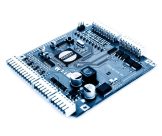
vehicle control unit
The HyperHybrid control system contains an electronic vehicle control unit and dedicated control algorithms embedded into its software.
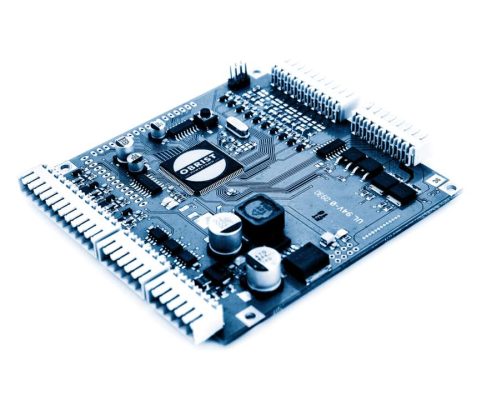
Unmatched driving experience
The HyperHybrid control system contains an electronic vehicle control unit and dedicated control algorithms embedded into its software. The control unit is connected to all relevant components of the powertrain and of the vehicle. Due to the central high speed signal processing and the smart distribution of computational power between the peripheral control units, the driving and on-ride charging modes of the vehicle can rapidly be adjusted to achieve maximum efficiency. The architecture and interfaces of the HyperHybrid control unit and of the single components are designed for rapid implementation in established car lines and for the integration of control units from other suppliers.
VEHICLE CONTROL UNIT
advantages at a glance
-
Application
-
Design
Features
The HyperHybrid control system is designed for several beneficial control features that provide automotive engineers with the toolbox to develop hybrid vehicles for an unmatched driving experience.
The architecture and interfaces of the HyperHybrid control unit and of the single components are designed for rapid implementation in established car lines.
- Dedicated Control Algorithms (embedded into its software)
- Smart Distribution of Computational Power
- Proprietary Control Units (for the generator-engine unit, the batteries and the thermal management)
- Decentralized Control Units (communicate directly to the controller via the CAN bus systems)
The HyperHybrid control system is designed for several beneficial control features that provide automotive engineers with the toolbox to develop hybrid vehicles for an unmatched driving experience.
The architecture and interfaces of the HyperHybrid control unit and of the single components are designed for rapid implementation in established car lines.
- Dedicated Control Algorithms (embedded into its software)
- Smart Distribution of Computational Power
- Proprietary Control Units (for the generator-engine unit, the batteries and the thermal management)
- Decentralized Control Units (communicate directly to the controller via the CAN bus systems)



